We translate numbers between binary and decimal systems "on the fly", the explanation "on the fingers"
Hello, Khabrovtsy.
The post could be called: “For fans to count on the fingers,” but we will find out later.
Introduction : But what to pull. All that comes next will go on the subject of counting in a binary system on fingers. Who still does not know, I will try to explain what it is, how and why to master it.
Perhaps, I’ll start with the advantages:
1. It is convenient to translate any number from decimal to binary and vice versa, without using a calculator.
2. The motility of the fingers develops.
3. The visual perception of binary numbers is developing.
Cons:
1. A little workout.
2. The numbers 26,27,352,378 and 891 must not be shown in public places.
Essence :
Many, for sure, had to translate between systems. And I think many remembered that:
2-10
3-11
4-100
5-101
, etc.
It is logical that based on the fact that each bit capacity has two states, we can depict this thing on the fingers.
Put your hand in front of you (palm toward you), bend your thumb. That is the unit. Bend the big one and bend the index, that's two. That is, an extended finger is 0, and a bent finger is 1. Since the leading zeros are discarded, we have a count from the “leftmost” unit.
The names of the fingers are those that are bent:
medium, large - 101 - 5
nameless, medium -1100 - 12
little finger, medium - 10100 - 20
To bend the little finger, you need some practice. But the point is different. Imagine the length of each finger as 2 ^ n (in the photo) That is, Now, imagine that we need to translate the number 25 into binary. We bend Pinky - 16, Nameless - 8 and large - 1. since 16 + 8 + 1 = 25. If you don’t understand, then here’s another example, the number 14, we think: The little finger is a lot, the average is normal, but you can take more, so we bend the nameless one, this is 8. Remember, then the middle one is +4, it's already 12 and the index one is + 2, result 14. Do the same with binary. Here, for example, we see somewhere: 1011101. We represent this on hands with bits (already two hands). 64 + 16 + 8 + 4 + 1 = 93 We have: 1011101 (2) = 93 (10) Conclusion
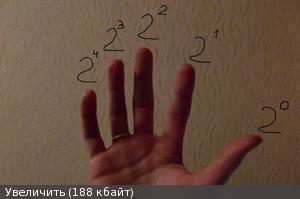
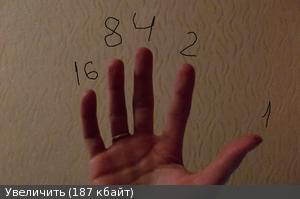
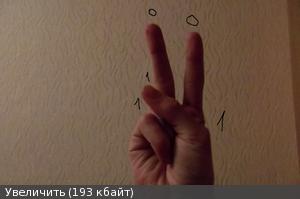
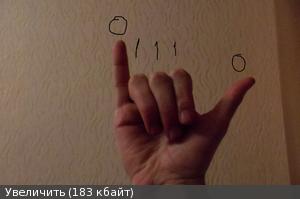
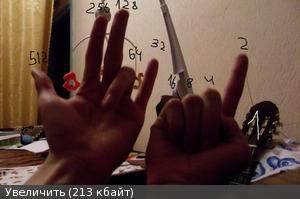
: Thus, we can use this method from 0 to 1023, using fingers and possessing elementary arithmetic. But with the addition of at least one category, it will be possible to count up to 2047, and then to 4095, 8191, etc. And it can be arms, legs, eyelids, or something else that can have two states 1 and 0.
The post could be called: “For fans to count on the fingers,” but we will find out later.
Introduction : But what to pull. All that comes next will go on the subject of counting in a binary system on fingers. Who still does not know, I will try to explain what it is, how and why to master it.
Perhaps, I’ll start with the advantages:
1. It is convenient to translate any number from decimal to binary and vice versa, without using a calculator.
2. The motility of the fingers develops.
3. The visual perception of binary numbers is developing.
Cons:
1. A little workout.
2. The numbers 26,27,352,378 and 891 must not be shown in public places.
Essence :
Many, for sure, had to translate between systems. And I think many remembered that:
2-10
3-11
4-100
5-101
, etc.
It is logical that based on the fact that each bit capacity has two states, we can depict this thing on the fingers.
Put your hand in front of you (palm toward you), bend your thumb. That is the unit. Bend the big one and bend the index, that's two. That is, an extended finger is 0, and a bent finger is 1. Since the leading zeros are discarded, we have a count from the “leftmost” unit.
The names of the fingers are those that are bent:
medium, large - 101 - 5
nameless, medium -1100 - 12
little finger, medium - 10100 - 20
To bend the little finger, you need some practice. But the point is different. Imagine the length of each finger as 2 ^ n (in the photo) That is, Now, imagine that we need to translate the number 25 into binary. We bend Pinky - 16, Nameless - 8 and large - 1. since 16 + 8 + 1 = 25. If you don’t understand, then here’s another example, the number 14, we think: The little finger is a lot, the average is normal, but you can take more, so we bend the nameless one, this is 8. Remember, then the middle one is +4, it's already 12 and the index one is + 2, result 14. Do the same with binary. Here, for example, we see somewhere: 1011101. We represent this on hands with bits (already two hands). 64 + 16 + 8 + 4 + 1 = 93 We have: 1011101 (2) = 93 (10) Conclusion





: Thus, we can use this method from 0 to 1023, using fingers and possessing elementary arithmetic. But with the addition of at least one category, it will be possible to count up to 2047, and then to 4095, 8191, etc. And it can be arms, legs, eyelids, or something else that can have two states 1 and 0.
